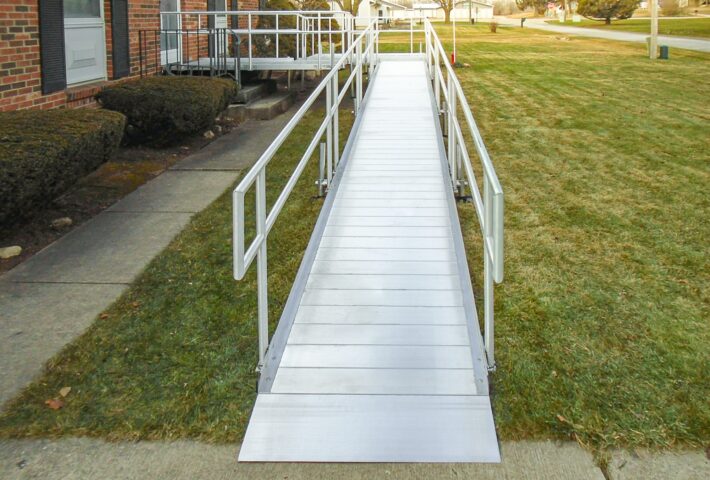
How to Choose the Right Wheelchair Ramp for Your Home
A Guide to WheelchairRamp Types and Standards
At Senior Home Solutions of Michigan, we help homeowners across Michigan choose the best accessibility options tailored to their needs, budget, and property layout. One of the most important decisions in that process is selecting the right type of home ramp and understanding the differences between residential and commercial standards.
When mobility becomes a challenge, whether due to age, injury, or disability, installing a handicap wheelchair ramp can dramatically improve independence and safety at home.
In this post, we’ll explore the key ramp types: aluminum ramps, wooden ramps, portable ramps, and steel ramps. We’ll also dive into the code requirements that affect ramp design for homes ramps compared to public or commercial spaces.
Residential vs. Commercial Ramp Standards
Before choosing a ramp system, it’s important to understand how residential handicap ramps differ from commercial ramps in terms of ADA ramp requirements and building code compliance..
Residential Ramp Standards
In Michigan, residential ramps must follow basic building safety codes, but they are not held to the full scope of ADA (Americans with Disabilities Act) standards unless the home is being used as a public facility. Still, we recommend that you follow ADA guidelines wherever possible for home ramps for your safety.
Typical residential ramp considerations:
-
- Wheelchair Ramp Slope: ADA recommends a 1:12 slope (1 inch of rise for every 12 inches of ramp). While residential ramps can legally be steeper, we strongly discourage it. A gentler slope is always safer.
- Ramp Width: At least 36 inches of clear width is ideal.
- Handrails: Required on ramps with a rise over 6 inches. Dual handrails at ADA-compliant heights improve safety.
- Wheelchair Ramp Slope: ADA recommends a 1:12 slope (1 inch of rise for every 12 inches of ramp). While residential ramps can legally be steeper, we strongly discourage it. A gentler slope is always safer.
Commercial Ramp Standards
Commercial ramps must strictly comply with ADA and Michigan Building Code:
-
- Slope: 1:12 max
- Landings: Flat landings are required every 30 feet and at the top/bottom.
- Handrails: Required on both sides.
- Edge protection: To prevent wheels from slipping off the ramp.
- Slope: 1:12 max
If you’re a business owner or are modifying a rental property, these standards are non-negotiable.
Here are your choices for residential wheelchair ramps:
1. Aluminum Wheelchair Ramps
Aluminum modular ramps are one of the most popular choices for both temporary and permanent installations. They’re lightweight, corrosion-resistant, and quick to install.
Pros:
- Durability: Aluminum resists rust and weathering, making it ideal for Michigan’s variable climate.
- Modular Design: These aluminum ramps can be configured to fit nearly any space and can be reconfigured or moved as needed.
- Low Maintenance: No painting, staining, or sealing required.
Quick Installation: Many aluminum ramps can be ordered and installed in just 1–2 days.
Cons:
- Cost: Slightly more expensive than wood ramps initially.
- Aesthetic: Some homeowners prefer a material that blends in more with the home’s architecture.
Best Use: Ideal for homeowners who want a reliable, safe, and quick-to-install handicap wheelchair ramp with minimal maintenance.
Learn More about our Wheelchair Installation service.
2. Portable Wheelchair Ramps
Portable ramps are compact, foldable, and easy to transport—making them a good choice for temporary needs or on-the-go accessibility.
Pros:
-
- Highly Mobile: Can be used in multiple locations—ideal for travel or rental homes.
- No Permits Needed: Since they’re temporary, most portable ramps don’t require a building permit.
- Lightweight Options: Many made from aluminum and easy to carry.
- Highly Mobile: Can be used in multiple locations—ideal for travel or rental homes.
Cons:
-
- Short Length: Most portable ramps are only 2–10 feet long—unsuitable for larger elevation changes.
- No Handrails: Lacks safety features like handrails or landing platforms.
- Limited Stability: Not as sturdy as permanent solutions; must be used on flat, stable surfaces.
- Short Length: Most portable ramps are only 2–10 feet long—unsuitable for larger elevation changes.
Best Use: Perfect for temporary use, travel, or quick solutions post-surgery or during rehab. Most of the time a portable wheelchair ramp is only suitable for one step, making them ideal for in home use.
3. Wooden Wheelchair Ramps
Wooden ramps offer a warm, natural look that blends well with most homes, especially when aesthetics are a priority. Some of the advantages of a wooden ramp include a custom appearance that can be painted or stained to match your home’s exterior. Wood can sometimes be affordable as well depending on the size of the wheelchair ramp.
Cons:
-
- Maintenance Required: Needs regular sealing to resist rot, warping, or splintering—especially during Michigan winters.
- Slippery When Wet: Requires anti-slip strips or textured paint.Not Modular: Permanent installation; more difficult to modify or remove.
- Maintenance Required: Needs regular sealing to resist rot, warping, or splintering—especially during Michigan winters.
Best Use: Great for permanent residential installations when appearance and custom design are important, and when homeowners are prepared for some ongoing maintenance. These wheelchair ramps are not ideal when an individual will be mobility impaired for a long period of time due to the year over year maintenance required.
4. Steel Wheelchair Ramps
Steel ramps are a rugged and durable option often used in high-traffic or heavy-duty applications. Some of the advantages are they are extremely durable and stay firmly in place when installed. These wheelchair ramps also have a long life as they are made of durable materials.
Cons:
-
- Heavy: Much heavier than aluminum or wood; harder to install or relocate.
- Corrosion: Will eventually rust if not properly coated or maintained.
- Higher Cost for Install: Installation often requires professional equipment and labor.
- Heavy: Much heavier than aluminum or wood; harder to install or relocate.
Best Use: Best for long-term, permanent installations in settings where strength and security are the top priority.
Which Ramp Is Right for You?
When choosing a wheelchair ramp, consider these key factors:
- Rise and Run: How much elevation change are you trying to overcome?
- Budget: Think not just about upfront cost, but also long-term maintenance.
- Permanency: Is this a short-term solution or a permanent home feature?
- Aesthetics: Do you want the ramp to blend with the home’s exterior?
- Mobility Needs: Will the ramp be used for a manual wheelchair, a power chair, or a scooter?
At Senior Home Solutions of Michigan, we offer free consultations to help you find the safest, most cost-effective ramp system for your unique situation. We rent and sellaluminum handicap ramps that can be installed in under 48 hours. The installation time of these ramp rentals or purchases is, on average, only 3 hours.
Don’t Compromise on Your Safety
It’s tempting to save money by buying a cheap ramp online or building something on your own, but improper slope, unstable materials, or lack of handrails can lead to serious injuries. We regularly see DIY ramps that are too steep, lack edge protection, or don’t comply with even basic safety standards.
Whether you choose aluminum, wood, portable, or steel, our team ensures your ramp is installed securely, meets all necessary codes, and most importantly keeps you or your loved one safe.
Are You Ready to Improve Your Home Accessibility?
Contact Senior Home Solutions of Michigan today at (586) 997-0750 or visit us at https://seniorhomesolutions.com to schedule your in-home consultation. Let our experienced team help you find the perfect handicap ramp solution because we believe mobility, safety, and independence should be available to everyone.



